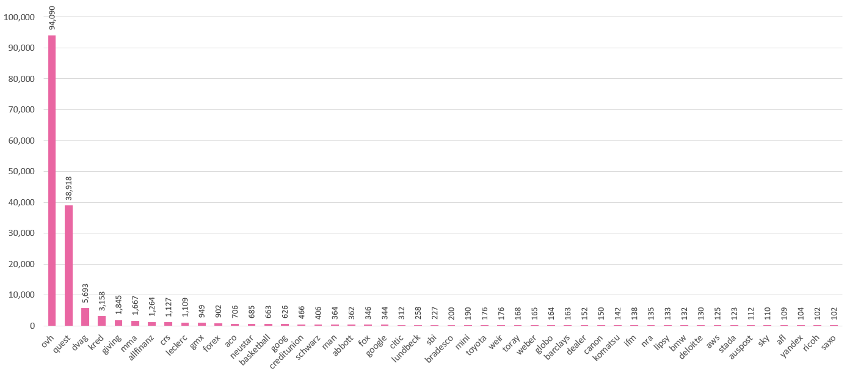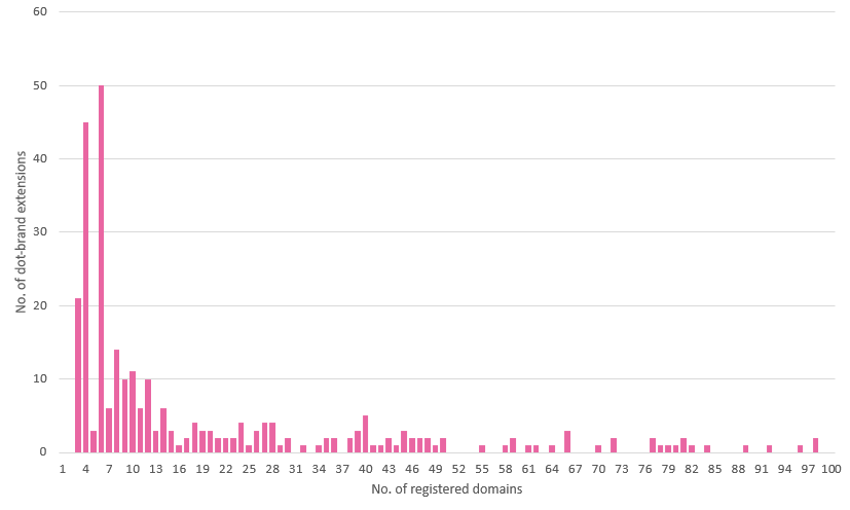
Our previous overview of the new-gTLD (domain extension) programme[1] comprised a top-level summary of the overall landscape; in this follow-up, we take a deeper dive into the set of dot-brand extensions.
Dot-brands are a special class of restricted new-gTLDs, where a brand owner has been granted the responsibility of overseeing the infrastructure of their own, brand-specific domain extension, with examples including .barclays and .bmw. This can be an attractive prospect for an organisation, as it gives them full control over all domains registered across the extension in question[2] and – providing they host all official websites on this branded extension and can successfully educate their customer base that this is the case – can make it a much more complex prospect for fraudsters to create fake sites. However, it is a costly enterprise to apply for (with just the initial evaluation fee reaching $185,000[3]) and run a dot-brand TLD, whereby the brand owner needs to act as a domain registry in their own right, requiring extensive investment in the necessary technological infrastructure[4]. There are also other considerations, such as the requirements to ‘rebuild’ search-engine rankings when switching over to a new corporate domain name[5]. Overall, these facts have led to a number of dot-brand applicants subsequently discontinuing use. Nevertheless, for large corporates, it is a possibility worth considering, particularly in view of the new round of gTLD applications set to launch in 2026[6].
As of December 2023, there are 421 dot-brand extensions currently delegated[7],[8] (i.e. added into the highest level of Internet infrastructure, the Root Zone, and therefore available for use). A significant study of the extent of their utilisation has been carried out by management consultancy DOTZON, in the sixth edition of their Digital Company Brands report[9]. This study considers factors such as the number of registered domains on each extension, the extent of use for e-mail communication, the proportion of domains resolving to live sites, and other search-engine optimisation statistics, to calculate a metric of the ‘digitalness’ of each company and its dot-brand TLD[10]. It is significant to note that European entities, particularly in Germany and France, feature highly in the list of dot-brand adopters, with insurance and finance as the top industries[11].
A simple piece of analysis is just to consider the total number of registered domains across each of the dot-brand extensions (where data is available, i.e. for 334 of the extensions)[12]. The top extensions, by numbers of domains, are shown in Figure 1.

Figure 1: Top dot-brand extensions, by number of registered domains (where data available)
The top ten are listed in Table 1.
|
TLD |
Owner |
No. domains |
|
.ovh |
OVH |
94,090 |
|
.quest |
Quest Software |
38,918 |
|
.dvag |
Deutsche Vermögensberatung |
5,693 |
|
.kred |
KredTLD |
3,158 |
|
.giving |
Giving Limited |
1,845 |
|
.mma |
MMA IARD |
1,667 |
|
.allfinanz |
Allfinanz Deutsche Vermögensberatung Aktiengesellschaft |
1,264 |
|
.crs |
Federated Co-operatives (Co-Operative Retailing System) |
1,127 |
|
.leclerc |
E.Leclerc |
1,109 |
|
.gmx |
1&1 Mail & Media (GMX, Global Message Exchange) |
949 |
Table 1: Top dot-brand extensions, by number of registered domains (where data available)
Overall, 48 of the extensions analysed have more than 100 domains registered. Of the dot-brands with fewer than this number, there is a significant proportion with only very small numbers of domains, as shown in Figure 2.

Figure 2: Number of dot-brand extensions with each number (between 1 and 100) of registered domains (where data available)
In total, 160 of the extensions analysed (48%) have ten registered domains or fewer.
Of course, the total number of registered domains on a dot-brand extension is not, in itself, a measure of how ‘well’ a brand owner is utilising the extension; it would be perfectly valid for a brand owner just to use (say) ‘www.[brand]’ as their sole corporate website, and nothing else. This arguably, presents the least risk of customer confusion. Nevertheless, a dot-brand extension does provide a number of compelling use-cases for brand owners, including possibilities for region-, product-, or corporate-division-specific sub-sites. For example, .mma and .allfinanz use subdomain names for individual financial consultants, and .bmw and .audi do likewise for specific dealerships. Studies from the last few years have consistently found that around three-quarters of dot-brand domains tend to resolve to active websites[13].
It is also informative to look at the most frequently used second-level domain names (SLDs, i.e. the part of the domain name to the left of the dot), across the dot-brand landscape. The top ten is shown in Table 2.
|
SLD |
No. instances |
|
www |
63 |
|
home |
61 |
|
go |
42 |
|
my |
39 |
|
|
38 |
|
careers |
34 |
|
global |
33 |
|
api |
32 |
|
cloud |
31 |
|
jobs |
28 |
Table 2: Most frequently used second-level domain names (for dot-brands where data available)
These trends are largely unchanged from a similar study carried out five years earlier[14], from which the top five SLDs all still appear in the current top six (though now with the addition of ‘go’).
A special case is the two-character SLD – two-character strings are often used to denote country codes, and in the case of the SLD for a dot-brand extension, can be used to create regional sub-sites. The top ten is shown in Table 3.
|
SLD |
No. instances |
|
go |
42 |
|
my |
39 |
|
id |
21 |
|
it |
17 |
|
de |
17 |
|
ai |
17 |
|
uk |
16 |
|
us |
16 |
|
in |
14 |
|
ru |
13 |
Table 3: Most frequently used two-character SLDs (for dot-brands where data available)
Many of these (particularly de, uk, us, ru) are likely to be used most frequently to refer to their respective countries (Germany, UK, US, Russia), whilst others (‘go’, ‘my’) are more likely to be used as readable keywords. It is also striking that ‘ai’ appears in the top ten, most likely a reflection of the growing popularity of artificial intelligence (AI) technologies, and their adoption by major corporations.
In general, insight into these frequently used keywords can be beneficial to organisations potentially looking to build out a dot-brand presence, providing guidance on common trends used to make websites navigable and avoid customer confusion, and also potentially to assist with conventions which may help to improve search-engine optimisation strategies.
[1] https://www.iamstobbs.com/opinion/expert-.watches-.new-.online-.website-.news-.lol-a-review-of-the-current-state-of-the-new-gtld-programme
[2] https://icannwiki.org/Brand_TLD
[3] https://newgtlds.icann.org/en/applicants/global-support/faqs/faqs-en
[4] https://circleid.com/posts/20200822-why-you-should-not-apply-for-a-dot-brand-new-gtld
[5] https://circleid.com/posts/20160927_seo_and_new_dot_brand_gtld
[6] https://www.iamstobbs.com/opinion/the-new-new-gtlds
[7] https://en.wikipedia.org/wiki/List_of_Internet_top-level_domains
[8] https://www.iana.org/domains/root/db
[9] https://dotzon.consulting/studien/
[10] https://circleid.com/posts/20231130-dotzon-study-digital-company-brands-2023; this study gives the top ten dot-brand TLDs as: leclerc, schwarz, audi, weber, mma, google, abbott, cern, lundbeck and allfinanz.
[11] https://www.worldipreview.com/contributed-article/global-adoption-of-dotbrand-domains
[12] This analysis is based on the versions of the ICANN zone-files downloaded on 04-Dec-2023. Analysis is only possible in cases where the respective zone-file is generally publicly available, which was not the case for 87 of the 421 extensions; however, zone-files were available for all of DOTZON’s top TLDs, with the exception of .audi.
[13] https://www.cscdbs.com/en/resources-news/dot-brand-report/
[14] https://www.cscglobal.com/cscglobal/pdfs/DBS/CSC_Dot_Brand_Insights_Report_Jun2018.pdf
Send us your thoughts:
Would you like to read more articles like this?
Building 1000
Cambridge Research Park
CB25 9PD
Fax. 01223 425258
info@iamstobbs.com
Privacy policy
German office legal notice
Cookie Declaration
Complaints Policy
Copyright © 2022 Stobbs IP
Registered Office: Building 1000, Cambridge Research Park, Cambridge, CB25 9PD.
VAT Number 155 4670 01.
Stobbs (IP) Limited and its directors and employees who are registered UK trade mark attorneys are regulated by IPReg www.ipreg.org.uk



